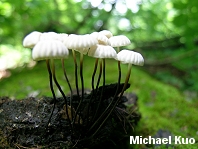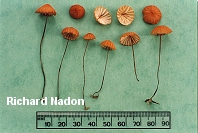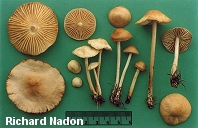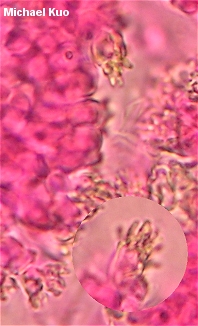Key to 60+ Marasmioid Mushrooms in North America
| 1. | Decomposing debris of plants (grasses, sedges, rushes, ferns, flowers, vines, etc.). | 2 |
| 1. | Decomposing tree litter. | 10 |
| 2. | Growing in grassy areas, in troops or fairy rings; cap 1–5 cm across and usually broadly bell-shaped, buff to tan; gills well spaced. | |
| 2. | Cap much smaller (rarely over 15 mm across); growing in grassy areas or not. | 3 |
| 3. | On litter of salal and Oregon grape; odor of garlic; Pacific Northwest. | Mycetinis salalis |
| 3. | Substrate different; odor not distinctive; variously distributed. | 4 |
| 4. | On litter of mountain avens or on living avens; arctic and alpine ecosystems. | Mycetinis epidryas |
| 4. | Substrate different; variously distributed. | 5 |
| 5. | Fresh cap white, buff, or pale (perhaps with a slightly darker center); western species. | 6 |
| 5. | Fresh cap more highly colored; eastern and western species. | 8 |
| 6. | Mature cap to only 2 mm across, buff to pale fawn with a cinnamon center; spores 8–12 x 4–6 µm. | Marasmius limosus |
| 7. | Cap pure white; spores 13–16 x 5–6.5 µm. | Marasmius caricis |
| 7. | Cap whitish with pinkish to cinnamon tinges over the center; spores 8–9 x 4 µm. | Marasmiellus vaillantii |
| 8. | Base of stem without prominent basal mycelium or fuzz; spores 7–11 x 3–5 µm. | Marasmius graminum |
| 8. | Base of stem with mycelium or fuzz; spores variously sized. | 9 |
| 9. | Pennsylvania to Louisiana and Illinois; spores 13–19 x 3.5–5 µm. | Marasmius pseudobambusinus |
| 9. | Widely distributed; spores 8.5–10.5 x 3.5–4 µm. | Marasmius armeniacus |
| 10. | On debris of conifers. | 11 |
| 10. | On debris of hardwoods. | 27 |
| 11. | Odor of garlic or onions, or strong and foul (crush a cap between your thumb and finger). | 12 |
| 11. | Odor not distinctive. | 16 |
| 12. | Odor strong and foul, but not of garlic or onions; on needles of spruce, fir, or pine (one or two mushrooms per needle); cap dull brown, beige, or nearly white. | |
| 12. | Odor distinctly of garlic or onions. | 13 |
| 13. | Mature cap extremely tiny (under 3 mm across); whitish, dull pinkish, or brownish gray. I see no convincing way to separate these two species, with or without a microscope. | Marasmiellus filopes
Marasmius thujinus |
| 13. | Mature cap larger than above (4 to 20 mm across); more highly colored. | 14 |
| 14. | Stem surface more or less velvety. | 15 |
| 15. | Scattered or in loose troops on litter of pines (Pinus species); maximum cap size about 10 mm; stem base inserted directly into needles; spores 7.5–9 x 3–4 µm. | Marasmius thiersii |
| 15. | In dense troops on litter of Douglas-fir, true firs (Abies species) or pines (Pinus species); maximum cap size about 20 mm; stem base not inserted directly; spores 9–10 x 5–6 µm. | Mycetinis applanatipes |
| 16. | Fresh cap whitish to very pale grayish or faintly pinkish. | 17 |
| 16. | Fresh cap more highly colored. | 18 |
| 17. | Growing from needles; gills not developing pinkish stains; stem remaining fairly pale; spores 9–10 µm long. | Marasmius calhouniae |
| 17. | Growing from twigs or small logs; gills often developing pinkish stains; stem darkening from the base up with age; spores 12–19 µm long. | |
| 18. | Fresh cap rose, pink, red, wine colored, purple-red, etc. | 19 |
| 18. | Fresh cap otherwise colored (orange, brown, orangish brown, cinnamon, rust, olive brown, yellow brown . . . ). | 21 |
| 19. | Cap conspicuously pleated; rose pink, fading to pinkish with a darker center; growing on needles east of the Rocky Mountains. | |
| 19. | Cap not conspicuously pleated; more highly colored when fresh; growing on various substrates; western. | 20 |
| 20. | Growing on well decayed wood; cap 5–20 mm across; gills often with a tiny tooth running down the stem; spores 8–13 x 3–4 µm. | Marasmiellus papillatus |
| 20. | Growing on humus; cap 10–40 mm across; gills often nearly free; spores 11–15 x 5–6.5 µm. | |
| 21. | Cap conspicuously pleated; eastern species. | 22 |
| 21. | Cap somewhat lined or not, but not conspicuously pleated; eastern and western species. | 23 |
| 22. | Fresh cap orange to brownish orange; common from about Tennessee northward; spores 16–23 x 3–4 µm; odor not distinctive; taste mild to slightly bitter; large cystidia with refractive contents present. | |
| 22. | Fresh cap cinnamon or rusty brown; common from about Tennessee southward; spores 15–18 x 3–4.5 µm; odor and taste often mealy; cystidia absent or rare (if present, without refractive contents). | Marasmius fulvoferrugineus |
| 23. | Cap olive brown, fading to light yellowish brown, pale olive brown, or grayish brown (the center often darker than the margin); often growing with ferns nearby; stem with a long root that extends into the substrate; spores shaped like lemons. | Rhizomarasmius undatus |
| 23. | Cap without olive tones; root lacking; spores otherwise shaped. | 24 |
| 24. | Growing on debris of redwoods on the West Coast; cap brown to brownish orange or orangish, 6-12 mm wide; taste (not odor) strongly garlic-like after 1–2 minutes. | Micromphale sequoiae |
| 24. | Not completely as above. | 25 |
| 25. | Cap more or less "brown," without orange shades. | 26 |
| 25. | Cap with orange to orange-brown shades, fading to dull apricot. | Marasmius armeniacus |
| 26. | Cap pale brownish or yellowish brown, with a darker brown center; gills without cystidia. | Marasmius pallidocephalus |
| 26. | Cap medium brown to dark brown; gill edges with upside-down mutant cow udders in miniature ("diverticulate" or "broom" cells) as cystidia. | |
| 27. | Growing from twigs or small logs; cap white, not pleated; stem darkening from the base up; gills often developing pinkish stains; spores 12–19 µm long. | |
| 27. | Not completely as above. | 28 |
| 28. | Growing on debris of other hardwoods. | 39 |
| 29. | Growing on petioles of sycamore leaves; cap minute, pale becoming pinkish brown. | |
| 30. | Growing on bark litter of madrone; cap to 1 cm across, brown; odor and taste of garlic or onions. | Micromphale arbuticola |
| 31. | Growing on litter of black locust; cap 4–13 mm across, pale orange (usually darker over the center and paler marginally), strongly or faintly pleated; recorded from Michigan but probably to be expected throughout the range of the tree. | Marasmius robinianus |
| 32. | Growing on leaf litter of American holly; cap minute, pale with a darker brownish center. | 33 |
| 33. | Gills attached by means of a collar that encircles the stem. | Marasmius ilicicola |
| 33. | Gills attached directly to the stem. | Marasmius ilicis |
| 34. | Growing on debris of tanoak. | 35 |
| 34. | Growing on debris of birch, quaking aspen, or black cottonwood. | 37 |
| 35. | Odor of garlic or onions; cap 5–10 mm across, dark reddish brown. | Marasmius thiersii |
| 35. | Odor not distinctive; other features variable. | 36 |
| 36. | Cap to 6 mm across, dark brown fading to light brown. | Marasmius quercophilus |
| 37. | Cap tiny (5 mm across maximum) and whitish. | 38 |
| 38. | Growing on leaves of birch or quaking aspen; spores 8–11 µm long; basidia 4-spored. | Marasmius epiphyllus |
| 38. | Growing on leaves of black cottonwood (Populus trichocarpa); spores 11–14 µm long; basidia 2-spored. | Marasmius tremulae |
| 39. | Odor of garlic or onions (crush a cap between your thumb and finger). | 40 |
| 39. | Odor not distinctive, somewhat foul, spermatic, bleachlike, mealy, or radishlike—but not of garlic. | 42 |
| 40. | Stem bald; most spores under 10 µm long; cheilocystidia digitate with many fingerlike projections. | |
| 40. | Stem hairy to finely velvety; most spores longer than 10 µm; cheilocystidia lumpy and lobed, with only a few, vaguely fingerlike projections. | 41 |
| 41. | Found in western North America. | Mycetinis copelandii |
| 41. | Found east of the Rocky Mountains. | Mycetinis olidus |
| 42. | Fresh cap rose pink, red, purplish red, or wine colored. | 43 |
| 42. | Fresh cap otherwise colored. | 47 |
| 43. | Found in western North America. | 44 |
| 43. | Found east of the Rocky Mountains. | 45 |
| 44. | Growing on well decayed wood; cap .5–2 cm across; gills often with a tiny tooth running down the stem; spores 8–13 x 3–4 µm. | Marasmiellus papillatus |
| 44. | Growing on humus; cap 1–4 cm across; gills often nearly free; spores 11–15 x 5–6.5 µm. | |
| 45. | Cap rose pink, fading to pinkish with a darker center. | |
| 45. | Cap purple red to red, perhaps fading to reddish brown. | 46 |
| 46. | Gills pinkish, often with red edges; spores 16–22 x 4–5.5 µm. | Marasmius haematocephalus |
| 46. | Gills whitish to yellowish, the edges colored like the faces; spores 8.5–12 x 3–4 µm. | Marasmius bellipes |
| 47. | Mature cap regularly at least 2–3 cm across (often even larger); stem not wiry. (If cap is 2–3 cm across and the stem is not wiry, try this choice first.) | 48 |
| 47. | Mature cap rarely as wide as 2–3 cm; stem wiry or not. | 54 |
| 48. | Cap whitish with a dark brown or reddish brown center; found in eastern North America. | |
| 49. | Entire stem remaining pale (whitish to yellow or very pale brownish) throughout development. | 50 |
| 49. | At least the lower portion of stem dark (brown, reddish brown, orange-brown, etc.) by maturity. | 51 |
| 50. | Growing from leaf litter; cystidia present only on gill edges. | |
| 50. | Growing from leaf litter, twigs, or logs; cystidia present on gill faces and edges. | Marasmius cystidiosus |
| 51. | Fresh cap pale (whitish, yellowish, pinkish cinnamon). | 52 |
| 51. | Fresh cap some shade of brown. | 53 |
| 52. | Mature cap whitish with a very slightly darker center, becoming somewhat wrinkled; gills with dextrinoid cystidia (setae). | |
| 52. | Mature cap pinkish cinnamon with a paler margin, not usually wrinkled; gills with colorless cystidia and broom cells. | Marasmius spissus |
| 53. | Often growing in clusters of 2–3 mushrooms; gills with dextrinoid cystidia (setae). | |
| 53. | Usually growing scattered to gregariously; gills with colorless to yellowish cystidia and broom cells. | |
| 54. | Fresh cap white or nearly so (pale yellowish, buff, cream). | 55 |
| 54. | Fresh cap more highly colored. | 64 |
| 55. | Cap conspicuously pleated. | 56 |
| 55. | Cap smooth to wrinkled or faintly lined, but not conspicuously pleated. | 57 |
| 56. | Usually growing on sticks, woody debris, and logs; cap at maturity with a flat top in side view. | |
| 56. | Usually growing on leaves; cap at maturity evenly rounded-convex in side view. | |
| 57. | Cap minute (2 mm maximum width); growing on leaves of American beech. | Marasmius epifagus |
| 58. | Stem surface smooth or minutely pubescent. | 59 |
| 58. | Stem surface finely to prominently hairy (use a hand lens on fresh specimens). | 60 |
| 59. | Cap 2–13 mm across; usually growing on sedges, rushes, ferns (etc.) but also recorded on twigs of alder, willow, beech, tulip poplar, sycamore, pine, and hemlock; cystidia not dextrinoid. | Marasmiellus vaillantii |
| 59. | Cap 7–40 mm across; usually growing on twigs or leaves of oaks, but recorded on debris of other hardwoods; cystidia dextrinoid. | |
| 60. | Entire stem remaining whitish or pale brownish over the course of development. | 61 |
| 60. | At least the bottom portion of the stem darkening to brown, dark brown, or black with maturity. | 62 |
| 61. | Growing from hardwood leaves or leaf stems, or from grasses or vines; pileipellis a hymeniform layer of broom cells. | Marasmius falcatipes |
| 61. | Growing from hardwood sticks; pileipellis a cutis with lobed or slightly diverticulate terminal elements. | |
| 62. | Stem soon black except at the apex; spores triangular to jack-shaped. | |
| 62. | Stem becoming brown to dark brown (if blackish, only at the base); spores ellipsoid to pip-shaped. | 63 |
| 63. | Threadlike black rhizomorphs often found in the substrate (sticks); gills sometimes discoloring orangish with age; pileipellis with setae; spores 13–20 µm long. | Marasmius tenerrius var. setulosis |
| 63. | Rhizomorphs absent; gills not discoloring orangish; pileipellis without setae; spores 8–13 µm long. | Marasmius epiphyllus |
| 64. | Color of fresh cap ranging from orange to orange-brown to rusty or reddish brown. | 65 |
| 64. | Color of fresh cap ranging from brown to light brown to yellow-brown to tan or olive brown. | 73 |
| 65. | Mature cap conspicuously pleated or prominently lined. | 66 |
| 65. | Mature cap smooth or faintly lined, but not conspicuously lined or pleated. | 70 |
| 66. | Spores under 12 µm in length; cap initially brown to yellow-brown but sometimes fading to orangish brown; growing on leaves. | Marasmius glabellus |
| 66. | Spores longer than 12 µm; cap with orange or rusty shades from the beginning; growing on leaves or woody debris. | 67 |
| 67. | Cap 3–8 mm across; rare; documented from Tennessee. | Marasmius haematocephalus var. anomaloides |
| 67. | Cap larger than above; common throughout eastern North America. | 68 |
| 68. | Found in northeastern North America from roughly the 43rd parallel northwards; many spores under 15 µm in length; odor reminiscent of Pleurotus ostreatus. | Marasmius borealis |
| 68. | Found south of the 43rd parallel or perhaps above it; nearly all spores longer than 15 µm; odor not distinctive or mealy. | 69 |
| 69. | Fresh cap orange to brownish orange; common from about Tennessee northward; spores 16–23 x 3–4 µm; odor not distinctive; taste mild to slightly bitter; large cystidia with refractive contents present. | |
| 69. | Fresh cap cinnamon or rusty brown; common from about Tennessee southward; spores 15–18 x 3–4.5 µm; odor and taste often mealy; cystidia absent or rare (if present, without refractive contents). | Marasmius fulvoferrugineus |
| 70. | Stem densely hairy, long and usually rooting somewhat; cap cuticle without broom cells. | |
| 70. | Stem smooth or very finely hairy, usually not rooting; cap cuticle with broom cells. | 71 |
| 71. | Found in northeastern North America from roughly the 43rd parallel northwards; spores over 12 µm in length; odor reminiscent of Pleurotus ostreatus. | Marasmius borealis |
| 71. | Widely distributed; spores shorter than 12 µm; odor not distinctive. | 72 |
| 72. | Apparently limited to eastern North America; cap 6–25 mm across, bright orange or dark orange-brown when fresh; broom cells and cystidia present on gills. | |
| 72. | Apparently widely distributed in North America; cap 4–12 mm across, orange to orangish but rarely bright orange; broom cells present on gills but not cystidia. | Marasmius armeniacus |
| 73. | Basal half of stem remaining fairly pale through maturity. | 74 |
| 73. | At least the basal half of the stem dark brown to black by maturity. | 75 |
| 74. | Stem usually eccentric (sometimes central); stature minute (cap 1–7 mm across, stem under 3 mm long). | Marasmius falcatipes |
| 74. | Stem usually central (sometimes slightly erratic); small but not minute (cap 3–24 mm across, stem 26–40 mm long). | Marasmius insipidus |
| 75. | Usually growing on curled, blackened ash leaves (but recorded on elm, poplar, and other hardwood leaves); cap minute (under 4 mm across), grayish brown to light brown. | Marasmius minutus |
| 75. | Not completely as above. | 76 |
| 76. | Growing on leaves of oaks or tanoak in western North America; cap minute (2–5 mm across), light brown over the center and paler marginally. | Marasmius quercophilus |
| 76. | Not completely as above. | 77 |
| 77. | Stem quite long (60–100 mm long), with a scurfy surface. | Marasmius chordalis |
| 77. | Stem shorter than above (between 5 and 65 mm long), with a smooth to faintly hairy or pubescent surface. | 78 |
| 78. | Spores under 12 µm long. | Marasmius glabellus |
| 78. | Spores over 13 µm long. | 79 |
| 79. | Cap conspicuously pleated at maturity; stem smooth; odor spermatic; spores 16–24 µm long. | Marasmius paludigenus |
| 79. | Cap wrinkled or somewhat lined along the margin at maturity, but not conspicuously pleated; stem faintly hairy or pubescent; odor not distinctive; spores 13.5–18 µm long. | Marasmius ciliatomarginatus |
References
Abesha, E. et al. (2003). Population genetics and spatial structure of the fairy ring fungus Marasmius oreades in a Norwegian sand dune ecosystem. Mycologia 95: 1021–1031.
Antonin, V. et al. (1997). Generic concepts within the groups of Marasmius and Collybia sensu lato. Mycotaxon 63: 359–368.
Antonin, V. & M. E. Noordeloos (2010). A monograph of marasmioid and collybioid fungi in Europe. Berchtesgaden, Germany: IHW Verlag. 480 pp.
Blenis, P. V. et al. (1997). Evaluation of fungicides and surfactants for control of fairy rings caused by Marasmius oreades (Bolt ex. Fr.) Fr. HortScience 32: 1077–1084.
Desjardin, D. E. (1985). New marasmioid fungi from California. Mycologia 77: 894–902.
Desjardin, D. E. (1987). The Agaricales (Gilled Fungi) of California. 7. Tricholomataceae I. Marasmioid Fungi: the Genera Baeospora, Crinipellis, Marasmiellus, Marasmius, Micromphale, and Strobilurus. Eureka, CA: Mad River Press. 99 pp.
Desjardin, D. E. (1987). New and noteworthy marasmioid fungi from California. Mycologia 79: 123–134.
Desjardin, D. E. & Petersen, R. H. (1989). Studies on Marasmius from eastern North America. II. New species. Mycotaxon 34: 71–92.
Desjardin, D. E. (1991). Studies on Marasmius from eastern North America. IV. Additions to Sect. Sicci. Mycologia 83: 30–39.
Desjardin, D. E., S. A. Gordon & R. H. Petersen (1993). Observations on two rhizomorph-forming species of Marasmiellus. Mycological Research 97: 111–122.
Desjardin, D. E. (1997). A synopsis of Marasmiellus in the southern Appalachian Mountains. Mycotaxon 65: 237–261.
Doyle, M. F. & Sundberg, W. J. (1989). The taxonomy, ecology, and distribution of Marasmius (Agaricales, Tricholomataceae) in Illinois. Transactions of the Illinois Academy of Science 82: 109–120.
Farnet, A. M. et al. (1999). Genotypic variations among isolates of Marasmius quercophilus, a white-rot fungus isolated from evergreen oak litter. Canadian Journal of Botany 77: 884–890.
Gilliam, M. S. (1975). New North American species of Marasmius. Mycologia 67: 817–844.
Gilliam, M. S. (1975). Marasmius section Chordales in the Northeastern United States and Canada. Contributions from the University of Michigan Herbarium 11: 25–40.
Gilliam, M. S. (1976). The genus Marasmius in the northeastern United States and adjacent Canada. Mycotaxon 4: 1–144.
Gordon, S. A. & Petersen, R. H. (1997). Infraspecific variation among geographically separated collections of Marasmius androsaceus. Mycological Research 101: 365–371.
Gordon, S. A. & Petersen, R. H. (1998). Infraspecific variation among geographically separated collections of Marasmius scorodonius. Mycotaxon 69: 453–466.
Gordon, S. A. et al. (1994). Mating systems in Marasmius: Additional evidence to support sectional consistency. Mycological Research 98: 200–204.
Halling, R. E. (1983). A synopsis of Marasmius section Globulares (Tricholomataceae) in the United States. Brittonia 35: 317–326.
McFarland, K. P. & Rimmer, C. C. (1996). Horsehair fungus, Marasmius androsaceus, used as nest lining by birds of the subalpine spruce-fir community in the northeastern United States. The Canadian Field-Naturalist 110: 541–543.
Moser, M. (1983). Keys to Agarics and Boleti (Polyporales, Boletales, Agaricales, Russulales). Ed. Kibby, G. Transl. Plant, S. London: Roger Phillips. 535 pp.
Noordeloos, M. (2018). Gymnopus (Pers.) Roussel. In Knudsen, H. & J. Vesterholt, eds. Funga Nordica: Agaricoid, boletoid, clavarioid, cyphelloid and gastroid genera. Copenhagen: Nordsvamp. 341–349.
Petersen, R. H. (2000). Rhizomarasmius, gen. nov. (Xerulaceae, Agaricales). Mycotaxon 75: 333–342.
Singer, R. (1958, 1959). Studies toward a monograph of the South American species of Marasmius. Sydowia 12: 54–145.
Singer, R. (1973). The genera Marasmiellus, Crepidotus and Simocybe in the neotropics. Germany: J. Cramer. 517 pp.
Wilson, A. W. & D. E. Desjardin (2005). Phylogenetic relationships in the gymnopoid and marasmioid fungi (Basidiomycetes, euagarics clade). Mycologia 97: 667–679.
This site contains no information about the edibility or toxicity of mushrooms.
Cite this page as:
Kuo, M. (2013, January). Marasmioid mushrooms. Retrieved from the MushroomExpert.Com Web site: http://www.mushroomexpert.com/marasmioid.html
|




